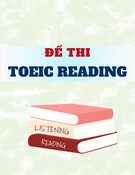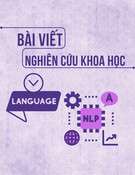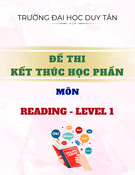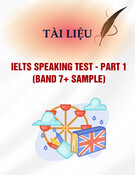
P-ISSN 1859-3585 E-ISSN 2615-9619 https://jst-haui.vn LANGUAGE - CULTURE Vol. 60 - No. 12 (Dec 2024) HaUI Journal of Science and Technology
83
USING TONGUE TWISTER TECHNIQUE TO IMPROVE FIRST-YEAR NON-ENGLISH MAJOR STUDENTS’ PRONUNCIATION
NÂNG CAO KỸ NĂNG PHÁT ÂM CỦA SINH VIÊN KHÔNG CHUYÊN TIẾNG ANH NĂM THỨ NHẤT BẰNG KỸ THUẬT TONGUE TWISTER Tran Thi Hoang Yen1,*, Nguyen Van Toan1 DOI: http://doi.org/10.57001/huih5804.2024.421 1. INTRODUCTION During the globalization, English is considered as a key subject in schools with a focus on four basic skills [1]. However, speaking is the most important and pronunciation is the primary barrier to effective communication [2]. After five years of teaching English, the author observed that certain problems related to pronunciation emerge among students and they pose the greatest challenge to effective communication when students learn speaking skills. While some students perform well in writing, reading, and listening, they find speaking particularly difficult. A lot of words, especially homophones like "sun", "son” are challenging for students to pronounce, and the correct uses of word stress, intonation or fluency are regularly overlooked [3]. It is Nation [4] that states, “When some teachers and students complain about difficulties in speaking, they are often talking about pronunciation”. Moreover, a study at Dalat ABSTRACT
Pronunciation is an essential element of effective English communication and needs a development
through various methods. The study investigates the application of tongue twister as a technique to improve
first-year non-English major students through a seven-
stage action research process. Quantitative data were
collected through pre- and post-
pronunciation tests, measuring students' improvement over the course while
qualitative insights were drawn from students’ refle
ctive reports to capture their personal experiences and
perspectives on the technique. The findings demonstrated that tongue twister led to significant improvements
in students' pronunciation of sounds, allowing for greater accuracy and consistency. Moreov
er, participants
showed marked progress in applying correct word stress, intonation patterns, and experienced a reduction in
pauses and hesitation for better fluency in their spoken English. Overall, the study highlights tongue twister as
a practical and e
ngaging strategy for improving various aspects of English pronunciation, making it a valuable
tool for teaching English, especially to non-English major students in their fields. Keywords: Tongue twister; pronunciation; action research; pronunciation test; reflective reports. TÓM TẮT Phát âm là yếu tố quan trọng để thực hiện giao tiếp tiếng Anh hiệu quả và cần được cải thiện với nhiề
u phương
pháp khác nhau. Bài báo trình bày việc áp dụng kỹ thuật tongue twister để tăng khả năng phát âm tiếng Anh củ
a
sinh viên không chuyên tiếng Anh năm thứ nhất thông qua bảy bước của phương pháp nghiên cứu hành động. D
ữ
liệu định lượng được thu thập thông qua các bài kiểm tra phát âm trước và sau khi áp dụng kỹ thuậ
t tongue twister,
phản ảnh sự tiến bộ của sinh viên trong suốt quá trình học, trong khi dữ liệu định tính được thu thập từ nhậ
t ký
nhận xét của sinh viên, ghi lại những trải nghiệm và quan điểm của họ về kỹ thuật này. Kết quả cho thấy, việ
c áp
dụng kỹ thuật tongue twister giúp cải thiện kỹ năng phát âm các âm một cách chính xác và nhấ
t quán hơn. Bên
cạnh đó, sinh viên tham gia nghiên cứu đã thể hiện rõ sự tiến bộ trong khả năng nhận biết trọng âm, sử dụng ng
ữ
điệu chính xác, đồng thời hạn chế các lỗi ngập ngừng và cải thiện tối đa sự trôi chảy khi phát âm tiế
ng Anh. Nhìn
chung, tongue twister là một kỹ thuật hiệu quả cải thiện nhiều khía cạnh của phát âm tiếng Anh cũng nh
ư là công
cụ ưu việt trong giảng dạy ngôn ngữ này, đặc biệt là cho sinh viên không chuyên. Từ khoá: Tongue twister; phát âm; nghiên cứu hành động; bài kiểm tra phát âm; nhật ký nhật xét. 1School of Languages and Tourism, Hanoi University of Industry, Vietnam *Email: yentth@haui.edu.vn Received: 05/9/2024 Revised: 28/10/2024 Accepted: 26/12/2024

VĂN HÓA https://jst-haui.vn Tạp chí Khoa học và Công nghệ Trường Đại học Công nghiệp Hà Nội Tập 60 - Số 12 (12/2024)
84
NGÔN NG
Ữ
P
-
ISSN 1859
-
3585
E
-
ISSN 2615
-
961
9
university with the participation of 210 English-major students in 2019 [5] shows that more than two-thirds of the participants in the study were unsuccessful in accurately pronouncing words due to English vowels and consonants as well as stress. Therefore, more pronunciation practice activities are required to improve students' speaking skills. It is tongue twisters that are phrases or sentences with similar sounds [6] present a solution to the difficulties in teaching and learning English pronunciation. The research was conducted to illustrate those benefits through two research questions: (1) To what extent does the use of tongue twister technique improve first-year non-English major students’ pronunciation at Hanoi University of Industry? (2) What are students’ attitudes towards tongue twister technique? In recent years, it has been acknowledged that most research has largely overlooked the spontaneous exploration of techniques to enhance English pronunciation in tertiary settings. Moreover, limited studies have focused on non-English major students. As a result, this study offers a valuable contribution to both the theory and practice of English teaching and learning. Theoretically, it helps identify the importance and key components of English pronunciation as well as provides research findings that can serve as reference materials of tongue twister for improving pronunciation instruction in higher education. Practically, it equips teachers with a deeper understanding of how to use the tongue twister technique to assist non-English major students in improving their English pronunciation skills; motivate students to be confident and improve their English pronunciation. 2. THEORETICAL FRAMEWORK AND METHODS 2.1. Theoretical framework 2.1.1. Pronunciation Experts have provided various definitions of pronunciation. Gilakjani [7] argues that it is a vital aspect of learning a foreign language, significantly influencing a learner's communication skills and overall performance. According to Pennington et al. [8], pronunciation involves a complex interaction of perceptual, articulatory, and interactional factors, characterized by segmental features (phonics), voice-setting features (speech stretches), and prosodic features (stress and intonation). Prommak [9] further states that pronunciation is an integral part of language learning, encompassing both segmental elements (such as consonants and vowels) and suprasegmental elements (like stress, intonation, rhythm, rate, and volume). Mastery of these components enhances communication, and by learning pronunciation, students aim to develop their communication competence [10]. For a straightforward and accurate explanation, the researchers adopted Prommak's [9] definition as their theoretical framework. Teaching pronunciation in English is essential, as it forms the foundation of effective communication. Mispronunciation can hinder intelligibility, making even simple words difficult to convey. Therefore, effective pronunciation instruction empowers students to express themselves confidently and encourages idea sharing [11]. Harmer [12] adds that pronunciation teaching enhances speaking skills and helps students understand sound characteristics. He states that “concentrating on sounds, showing where they are made in the mouth, making students aware of where words should be stressed – all these things give them extra information about spoken English and help them achieve the goal of improved comprehension and intelligibility” (p.187). In the past, Celce-Murcia et al. [13] also appreciated the importance of pronunciation teaching as well as identified some kinds of technique and practice materials for pronunciation instruction. The techniques and materials they mentioned include (1) Listen and imitate, (2) Phonetic training, (3) Minimal pair drills, (4) Contextualized minimal pairs, (5) Visual aids, (6) Tongue twisters, (7) Developmental approximation drills, (8) Practice of vowels shifts and stress related by affixation, (9) Reading aloud/ recitation, (10) Recording of learners’ production. 2.1.2. Tongue twister There are a wide range of definitions of tongue twister given by experts in the world. Sukiani [14] describes them as challenging sequences of words due to similar sounds. Besides, Machackova [4] adds that they consist of difficult-to-pronounce phrases and serve as a fun way to improve English proficiency. In addition, Danijela [15] notes that tongue twisters act as pronunciation exercises, mimicking normal speech's stress, rhythm, and intonation while requiring quick adjustments in mouth and tongue movements. From the aforementioned comments, the researchers conclude that tongue twisters, though challenging because of their repetitive sound patterns, can be effective and humorous activities in the classroom.

P-ISSN 1859-3585 E-ISSN 2615-9619 https://jst-haui.vn LANGUAGE - CULTURE Vol. 60 - No. 12 (Dec 2024) HaUI Journal of Science and Technology
85
According to Goldrick et al. [16], phonological planning errors are caused by the tongue twister paradigm. The repeating of certain sounds, words, or phrases with an emphasis on pronunciation, stress, intonation, pace, and speech are the hallmarks of tongue twisters. Additionally, tongue twisters are meant to assist students in differentiating between similar and perplexing letter sounds. According to Lutfiani [10], the tongue twister exercises begin with having students repeat a variety of tongue twisters and go faster or to come up with some original verses. The examples are those such as “Sally sells seashells by the seashore” or “Bubby baby buggy bumpers” or “Busy Barry Bear barely bakes berries” or “Peter Pepper picked a peck of pickled peppers”. Through the study on tongue twisters in pronunciation class, Sitoresmi [17] concluded some advantages: (1) improving their motivation as a result of various activities conducted during the course; (2) making students relax, be more excited in practicing their pronunciation inside or outside of classroom; (3) enhancing students’ pronunciation ability; (4) creating more exciting and relax atmosphere in classroom; (5) is a good exercise of the mouth and muscles when pronouncing words. 2.2. Research methods The study surveyed 27 freshman students majoring Mechanical Engineering at Hanoi University of Industry with varying levels of English proficiency. The majority of the participants exhibit an elementary level of English proficiency (equivalent to level 2 according to CEFR), indicative of their non-English major background. Those students were chosen for the study because they experienced the blended-learning model at university and spent most of offline time in classrooms practicing speaking English. By examining experiences of these students, the research aims to shed light on the effectiveness of tongue twister in enhancing their English pronunciation. The researcher employed classroom action research as the most effective method for addressing the issues. Putri et al. [18] suggest that action research is a strategy for enhancing education by implementing changes and learning from their outcomes. Especially, the seven steps developed in the action research model by McBride et al. [19] are fundamentally iterative, exploratory, and cyclical, which results in the authors’ decision to adapt the model to their study's design, taking into account the tertiary context, the number of participants, and the nature of their responses. Figure 1. The seven steps of action research (1) Through four years of teaching at HaUI, the authors observed that students had a very weak pronunciation ability, which significantly hindered their communication proficiency. Students often struggled with pronouncing vowels and consonants, and frequently neglected word stress and intonation. These issues made their speech unclear and had a detrimental effect on their overall fluency. (2) A pronunciation pre-test was conducted to collect preliminary data on students’ pronunciation ability. (3) The researchers determined from the pre-test results that students' challenges with sound pronunciation, word stress, intonation, and fluency were the main factors contributing to ineffective English communication. (4) The researcher developed a suitable action plan for the study based on the pre-test results. In this stage, all necessary materials for English teaching and learning at HaUI were prepared. As the first two weeks were dedicated to gathering and analyzing data from the pre-test, the researcher scheduled the implementation of the tongue twister technique to begin in the third week. (5) The action plan was carried out over six weeks by incorporating the tongue twister strategy into EFL classroom lessons with some steps. Firstly, students were introduced to the key features of the tongue twister technique and guided in using it to improve their pronunciation. For each unit with a topic, teachers specifically instructed some common phonemes in the unit and introduced the appropriate tongue twisters.

VĂN HÓA https://jst-haui.vn Tạp chí Khoa học và Công nghệ Trường Đại học Công nghiệp Hà Nội Tập 60 - Số 12 (12/2024)
86
NGÔN NG
Ữ
P
-
ISSN 1859
-
3585
E
-
ISSN 2615
-
961
9
After that, teachers gave the examples to use the correct intonation and word stress with those tongue twisters by showing videos and explaining the rules. For improvement of fluency, teachers let students to practice tongue twister tasks such as reading, drilling, whispering, etc. and also motivated them to practice in front of others for peer and teacher feedback. After each unit, students were also tasked with submitting a speaking video featuring those tongue twisters as homework and got feedback from teachers. (6) A pronunciation post-test with the same format and similar level of difficulty to the pre-test was conducted to evaluate the students' progress in pronunciation, while their reflective journals were utilized to capture their attitudes and experiences with using the technique. (7) The researchers analyzed and compared the results of the pronunciation post-test and the pre-test in order to determine the effects of using tongue twister technique. Besides, the feedback from reflective journals were then analyzed to assess students’ perspectives on the application of this technique. 2.2.1. Data collection and analysis instruments 2.2.1.1. Pronunciation tests To assess improvements in students' pronunciation, the author employed two pronunciation tests with the similar level of difficulty before and after practicing tongue twisters. These pre- and post-tests were adapted with the same format from a pronunciation test (2017) of the faculty of Foreign Language in HaUI for English majored students. Each pronunciation test consists of two sections: the first requires students to pronounce 20 single words (including 10 minimal pairs), while the second involves reading a paragraph of about 10 sentences that features common vocabulary found in the textbook. The assessment is based on four criteria: sounds, stress, intonation, and fluency. The first section evaluates students’ pronunciation concerning sounds and stress, while the second focuses on intonation and fluency. Each test is scored out of a total of 40 points, with each criterion receiving an equal allocation of 10 points. To ensure the reliability of the test results, the author made use of the software SPSS version 20.0 as the major tool for statistical analysis of the data. T-test was used to identify the significant differences (p-value) between pre-test and post-test which could illustrate the improvement of students’ pronunciation ability after tongue twister instruction. One of two cases appear after the analysis on SPSS: (1) If p-value is less than or equal to the significance level of 0.05 (p ≤ 0.05), it can be understood that there is an effect of tongue twisters on improving first-year non-English major students’ pronunciation; (2) If p-value is bigger than the significance level of 0.05 (p > 0.05), it’s concluded that there is no effect of tongue twisters on improving first-year non-English major students’ pronunciation. 2.2.1.2. Reflective reports Following each practice session of tongue twisters, students were given the task of writing in a journal to capture their attitudes, feelings, and insights about their practice. This study modified Lindsey's [20] reflective journal model, which included one open-ended question about students' perceptions of using tongue twisters to enhance pronunciation. Moreover, the author also decided to adopt Creswell [21]’s content analysis method to analyze the data in journals with 6 steps: (1) Read through the students’ journals, then categorized them; (2) Filter to get the suitable journals and determine the main ideas for analysis; (3) Read all selected data and divide them two opposing tendencies as positive and negative; (4) Code all the data based on hierarchical frames with three levels (tongue twister description, specification of students’ attitude, the attribute or specific theme associated with tongue twister); (5) Connect the themes and description. The results of the analysis were presented in this study using narrative passages; (6) Interpret the findings and outcomes. Figure 2. Creswell’s content analysis method [21]

P-ISSN 1859-3585 E-ISSN 2615-9619 https://jst-haui.vn LANGUAGE - CULTURE Vol. 60 - No. 12 (Dec 2024) HaUI Journal of Science and Technology
87
3. RESULTS Based on the results of the pre-test and post-test, tongue twister was illustrated to bring significant improvement of English pronunciation as follows: (1) The tongue twister technique helped students to pronounce English sounds correctly Students’ ability to pronounce English sounds improved by applying the tongue twister technique through strategies such as: listening and repeating after the audio and teachers, pronouncing and repeating vocabularies, reading the tongue twister chains in which each sound is integrated. In the giving an example of tongue twister sentences, the teacher acted as the instructor to introduce the focus phonemes in each topic to help students to distinguish the sounds, memorize and pronounce them correctly. The results of two pronunciation tests showed that approximately 74.1% of students (20 out of 27 students) got higher scores of sounds in the post-test, 14.8% (4 students) remained the scores compared to the pre-test while 11.11% (3 students) received lower scores. The average score was 5.74, making it the second highest among the four criteria. (2) The tongue twister technique improved students’ ability to use correct stress Students' ability to use correct word and sentence stress in English improved through the tongue twister technique, which included memorizing stress rules, listening and repeating words, and reading sentences while identifying key phonemes. The teacher modeled correct pronunciation and explained stress rules, such as the different stress on "record" (/ˈrek.ɔːd/ as a noun and /rɪˈkɔːd/ as a verb). After practicing, the teacher had students repeat after her/him. Pronunciation tests showed that 18 students (about 66.67%) achieved better stress results, with an average score of 5.185 in the post-test, while 5 students (18.52%) maintained their scores, and 4 students (14.81%) scored lower. (3) The tongue twister technique enhanced students’ ability to use correct intonation in speaking an expression Using the tongue twister technique enhanced students' ability to use proper intonation. Teachers employed effective strategies such as showing videos of tongue twister sentences, providing examples of correct intonation, discussing topic-related expressions, and having students practice through repetition. This approach helped students differentiate intonation in various contexts and become accustomed to using appropriate intonation. For example, falling intonation is used in statements or Wh-question like “I wish to wash my Irish wristwatch”, “Which wristwatches are Swiss wristwatches?” while rising intonation appears in yes-no questions like “Can you catch a can canner canning a can?” As a result, 23 students (85%) saw score increases of 1 to 2 points after two pronunciation tests, and no student experienced a decrease in their intonation scores. (4) The tongue twister technique improved students’ speaking fluency and ability to decrease pauses and hesitation in pronouncing the English words By reading and repeating interesting words chains in tongue twister sentences, students became more familiar, more flexible to pronounce English words and could avoid the hesitation and pauses. For the beginning phase, teachers did modeling by reading tongue twister sentences at slow speed, medium speed and then fast speed with the nice fluency. To make students more confident and enthusiastic, teachers then asked students to come to the front and practice the sentences at different speed as well as gave the appropriate feedback for them to improve. The pauses and word repetitions obviously decreased, which was shown in the results of the post-test. While 24 students (88.9%) got higher scores in terms of fluency with an average score of 6.148 - the highest one in four criteria, only 2 students (7.4%) remained their scores in terms of fluency in the post-test and a student (3.7%) received the lower score. Table 1. Paired Samples Statistics of pre-test and post-test N Mean P-value Pre-test Post-test Sounds 27 4.889 5.740 0.000 Stress 27 4.667 5.185 0.001 Intonation 27 4.407 5.333 0.000 Fluency 27 4.963 6.148 0.000 Total 27 18.926 22.406 0.000 It can be seen in the table 1 that there was a difference of 3.48 between the total mean scores of the post-test and pre-test in which the difference for sounds criteria is 0.851, for stress criteria is 0.518, for intonation criteria is 0.926 and for fluency is 1.185, significantly greater than zero. It means that tongue twister technique was effective to improve the students’ pronunciation.












![Đề cương môn Tiếng Anh 1 [Chuẩn Nhất/Mới Nhất]](https://cdn.tailieu.vn/images/document/thumbnail/2025/20251130/cubabep141@gmail.com/135x160/51711764555685.jpg)










![Mẫu thư Tiếng Anh: Tài liệu [Mô tả chi tiết hơn về loại tài liệu hoặc mục đích sử dụng]](https://cdn.tailieu.vn/images/document/thumbnail/2025/20250814/vinhsannguyenphuc@gmail.com/135x160/71321755225259.jpg)


